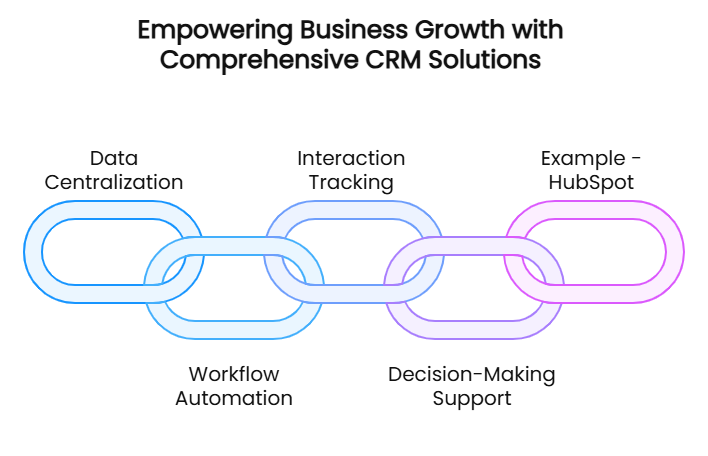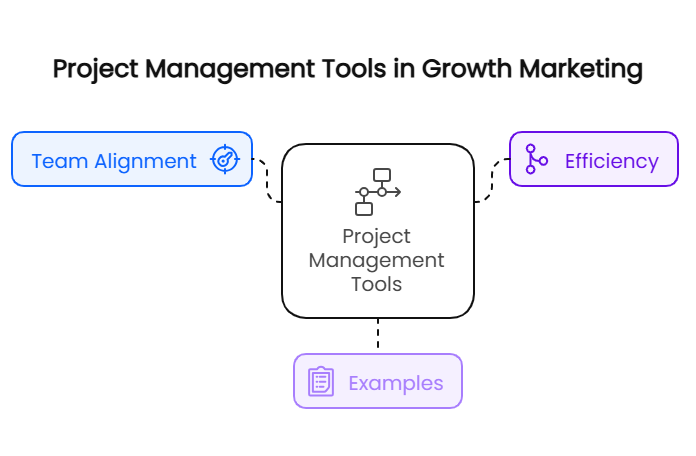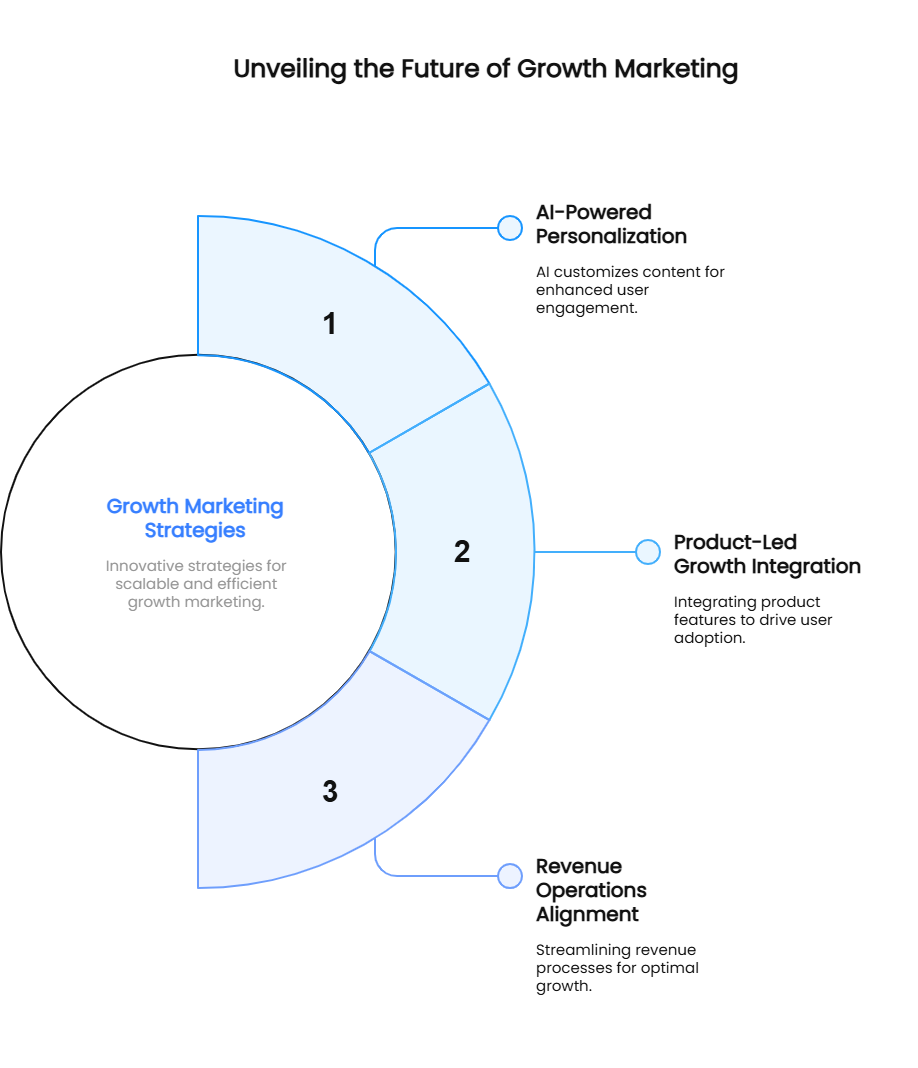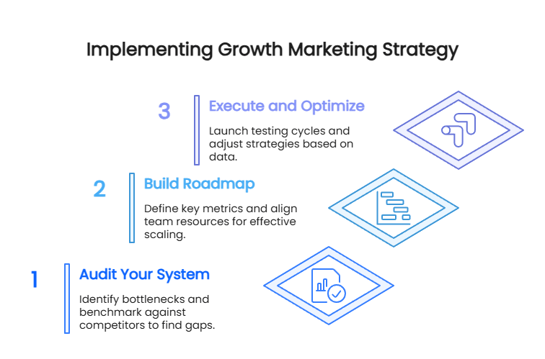Growth Marketing + Technology
Essential Tools for Scaling
We have established that growth marketing requires a data-driven, automated, and highly efficient approach to customer acquisition, retention, and revenue expansion. To achieve this, you need the right tools.
Growth marketing tools can help you:
- Automate repetitive tasks, so your team can focus on high-impact strategy
- Gain real-time insights into what’s working (and what’s not)
- Optimize performance across every channel
Essential Tech Stack for Growth Marketing
CRM and Core Platform
What It Is: A Customer Relationship Management (CRM) system is the backbone of your marketing, sales, and customer success efforts. It centralizes data, automates workflows, and tracks interactions to drive better decision-making.
Why You Need It: Without a CRM, leads slip through the cracks, sales cycles slow down, and customer relationships suffer. A strong CRM streamlines communication, improves follow-ups, and ensures no opportunity is wasted.
Example: HubSpot
HubSpot offers an all-in-one CRM with marketing automation, sales tracking, and customer service tools. It's easy to use, scalable, and designed to align teams for faster growth and better retention.

SEO & Competitive Intelligence
What It Is: A Customer Relationship Management (CRM) system is the backbone of your marketing, sales, and customer success efforts. It centralizes data, automates workflows, and tracks interactions to drive better decision-making.
Why You Need It: If your ideal customers can't find you, they won't buy from you. A strong SEO strategy ensures you show up ahead of competitors and capture high-intent traffic.
Example: Semrush
SEMrush provides keyword research, backlink analysis, and site audits to help you dominate search results. It also tracks competitor strategies, so you can outrank and outperform in your industry.
Related Read: Outsourced Marketing Services: Pros, Cons, & How to Hire the Right Team
User Behavior Analysis
What It Is: User behavior tools show how visitors interact with your site through heatmaps, session recordings, and click tracking.
Why You Need It: If your website isn't converting, you need to know why. These insights help identify friction points so you can optimize UX and increase conversions.
Example: HotJar
Hotjar provides visual insights into user behavior, showing where visitors scroll, click, and drop off, helping you refine page layouts, CTAs, and user flows for better engagement.
Related Read: Data-driven Growth Marketing: The Path to Success [With Examples]

Team Collaboration & Workflow Management
What It Is: Project management tools keep marketing, sales, and product teams aligned by centralizing tasks, deadlines, and approvals.
Related Read: Product-Led Growth vs. Sales-Led Growth: Which is Best for You
Why You Need It: Misalignment slows execution. A structured workflow ensures teams stay organized, efficient, and focused on high-impact work.
Example: Monday.com / Asana
Both tools help streamline project management by automating task assignments, tracking progress, and ensuring nothing falls through the cracks—so teams can execute faster.
Related Read: How to Build a Marketing Team for Growth: Roles, Tools, & Hiring Tips

AI-Powered Content & Messaging
What It Is: AI-driven tools help generate, refine, and optimize marketing copy across ads, emails, blogs, and landing pages. The key is not to use generic tools like standard ChatGPT or Claude.ai, but to leverage trained, branded AI.
Why You Need It: Content marketing at scale requires speed and consistency. AI helps brainstorm ideas, test variations, and optimize messaging, helping you get to a top-tier result more quickly than manual efforts alone can achieve.
Example: Lean Labs AI Agents

We've developed a collection of tools designed to provide tailored results, recommendations, and copy based on your brand guidelines, goals, and voice. Check out our agent page to see our current free trials.
The Future of Growth Marketing
The only constant in marketing is change. Winning SaaS companies aren’t crushing their growth goals by sticking to their same old playbooks. They’re leveraging AI, automation, and data-driven strategies to scale smarter, convert faster, and retain better.
Here are some of the trends shaping the next era of growth marketing for brands like yours.
Related Read: How We Execute Lean Marketing to Reduce Waste and Accelerate Results
AI-Powered Personalization
- Dynamic content adaptation – AI customizes messaging based on user behavior
- Predictive lead scoring – Machine learning prioritizes high-intent prospects
- Automated optimization – Campaigns auto-adjust based on performance data
Why It Matters
Moving forward, personalization won’t be a “nice-to-have,” it’ll be table stakes.
Product-Led Growth (PLG) Integration
- Seamless product-marketing alignment – Marketing fuels adoption, not just MQLs
- In-product growth loops – Features that drive viral adoption (referrals, upgrades)
- Self-serve conversion paths – Trial-to-paid flows that reduce sales friction
Why It Matters
PLG-first SaaS companies grow faster with lower CAC and higher retention.
Revenue Operations (RevOps) Alignment
- Unified revenue teams – No more silos between sales, marketing, and customer success
- Integrated tech stacks – CRM, automation, and analytics work together seamlessly
- Clear attribution across touchpoints – Know exactly what’s driving revenue growth
Why It Matters
Growth isn’t just about new customer acquisition, it’s about optimizing every revenue-generating function in your organization.

Next Steps
Implementing Your Growth Marketing Strategy
To get the most from your marketing efforts, you need a structured approach. Follow this simple, three-step process to eliminate the guesswork from your growth marketing implementation.
Step 1
Audit Your Current Growth System
- Identify your biggest growth bottlenecks - Where are leads dropping off?
- Benchmark against competitors - Are you ahead or falling behind?
- Map your tech stack gaps - Do you have the right tools to scale effectively?
You can’t fix what you don’t measure. You need to find the gaps in your funnel before you can begin to fill them.
Step 2
Build Your Growth Roadmap
- Define key metrics and targets - What KPIs matter most?
- Set clear quarterly objectives - Focus on measurable, revenue-driven goals
- Align team resources - Ensure marketing, sales, and product teams are in sync
Scaling without a plan leads to wasted spend and misaligned teams. Need help getting your plan in place? Schedule a free Growth Mapping Session with our Head of Growth today to get on the right track.
Step 3
Execute and Optimize
- Launch rapid testing cycles - Experiment with messaging, channels, and offers
- Monitor core metrics daily - Don’t wait until next quarter to spot a failing strategy
- Adjust based on data, not hunches - Let analytics drive your next move
Great SaaS companies test, learn, and adapt at speed. The best SaaS companies employ the help of an experienced growth partner to lead them through their growth marketing journey.
If you want to see exactly how we’d implement a growth marketing approach if we were in your shoes, book a Growth Mapping Session with us today.





.png?width=695&height=296&name=_-%20visual%20selection%20(3).png)
.png?width=624&height=456&name=_-%20visual%20selection%20(2).png)

.png?width=673&height=479&name=_-%20visual%20selection%20(1).png)











